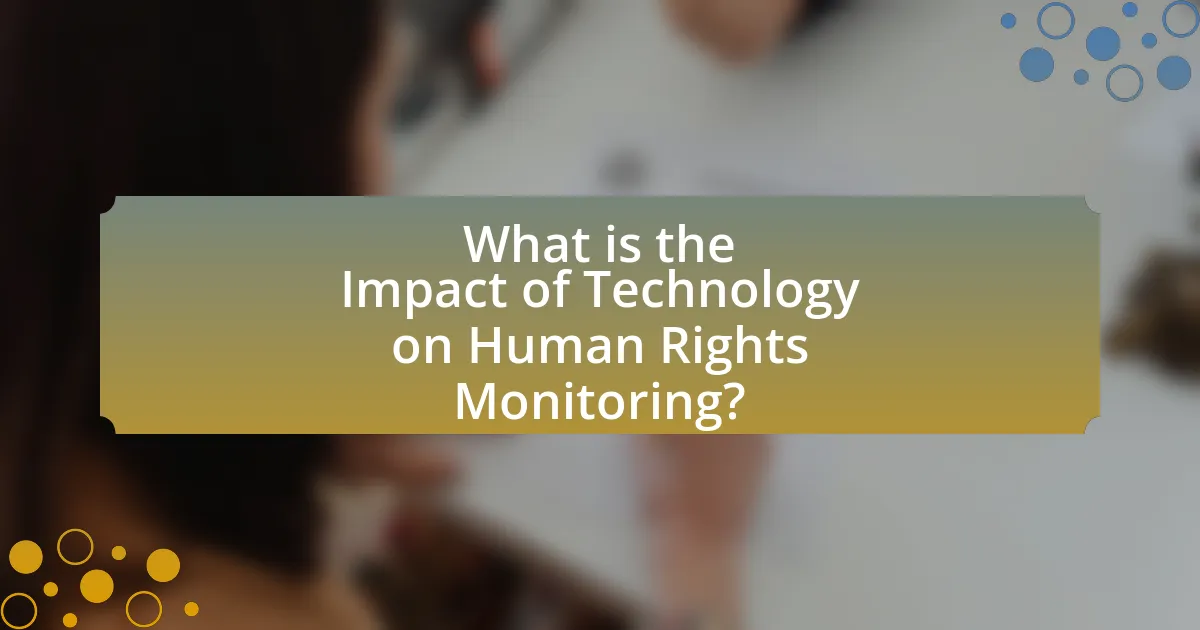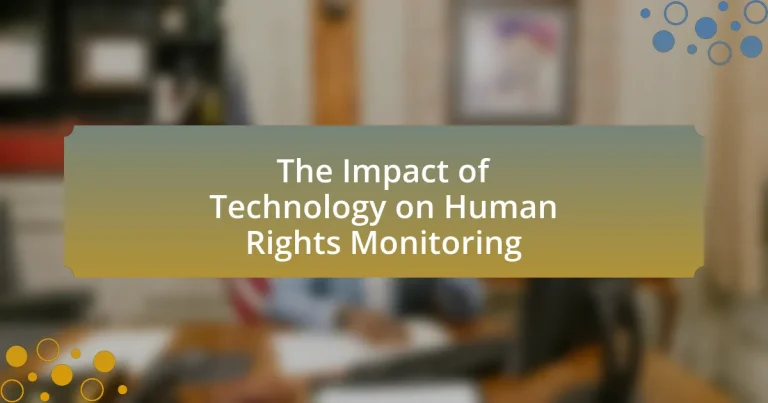The article examines the impact of technology on human rights monitoring, highlighting how advancements such as satellite imagery, social media analytics, and artificial intelligence enhance data collection, analysis, and dissemination. It discusses the evolution of these technologies, their role in improving transparency and accountability, and the challenges they pose, including surveillance and misinformation. Additionally, the article outlines best practices for ethical technology use in human rights efforts and explores future trends that could further influence monitoring capabilities. Overall, it emphasizes the transformative potential of technology in facilitating timely interventions and effective advocacy for human rights.

What is the Impact of Technology on Human Rights Monitoring?
Technology significantly enhances human rights monitoring by improving data collection, analysis, and dissemination. Tools such as satellite imagery, social media monitoring, and mobile applications enable real-time reporting of human rights abuses, allowing organizations to respond more swiftly. For instance, the use of satellite technology has been pivotal in documenting atrocities in conflict zones, as seen in the monitoring of the Syrian civil war, where organizations like Human Rights Watch utilized satellite images to verify reports of attacks on civilian infrastructure. Additionally, data analytics can identify patterns of abuse, facilitating targeted interventions. The integration of technology in human rights monitoring thus leads to more effective advocacy and accountability measures.
How has technology evolved in the context of human rights monitoring?
Technology has evolved significantly in the context of human rights monitoring by integrating advanced tools such as satellite imagery, social media analytics, and artificial intelligence. These innovations enable real-time data collection and analysis, enhancing the ability to document human rights abuses. For instance, organizations like Human Rights Watch and Amnesty International utilize satellite imagery to verify reports of violence and displacement, providing concrete evidence of violations. Additionally, social media platforms serve as vital sources for gathering eyewitness accounts and mobilizing international attention, while AI algorithms analyze vast amounts of data to identify patterns of abuse. This evolution has transformed human rights monitoring from traditional methods to a more dynamic, evidence-based approach, allowing for timely interventions and accountability.
What technological advancements have been most influential?
The most influential technological advancements include the internet, mobile technology, and artificial intelligence. The internet has revolutionized communication and information dissemination, enabling real-time reporting and awareness of human rights violations globally. Mobile technology has facilitated the documentation and sharing of evidence through smartphones, empowering activists and organizations to mobilize support quickly. Artificial intelligence enhances data analysis and pattern recognition, allowing for more effective monitoring of human rights abuses. These advancements have collectively transformed the landscape of human rights monitoring, making it more accessible and impactful.
How do these advancements change the landscape of human rights monitoring?
Advancements in technology significantly enhance the landscape of human rights monitoring by enabling real-time data collection and analysis. Technologies such as satellite imagery, social media monitoring, and artificial intelligence facilitate the identification and documentation of human rights abuses more efficiently than traditional methods. For instance, satellite imagery has been used to monitor mass atrocities in regions like Darfur, providing concrete evidence of violations that can be utilized in international courts. Additionally, AI algorithms can analyze vast amounts of social media data to detect patterns of abuse, allowing organizations to respond swiftly. These technological tools not only improve the accuracy of reporting but also increase the accessibility of information, empowering activists and organizations to advocate for human rights more effectively.
Why is technology important for human rights monitoring?
Technology is important for human rights monitoring because it enhances the ability to collect, analyze, and disseminate information regarding human rights violations. For instance, tools such as satellite imagery and mobile reporting applications allow organizations to document abuses in real-time, providing evidence that can be used in legal proceedings or advocacy efforts. According to a report by Human Rights Watch, the use of technology has significantly improved the accuracy and speed of reporting incidents, enabling quicker responses to human rights crises. Furthermore, data analytics can identify patterns of abuse, helping organizations prioritize their interventions effectively.
What role does technology play in data collection and analysis?
Technology plays a crucial role in data collection and analysis by enabling efficient, accurate, and scalable methods for gathering and interpreting information. Advanced tools such as data mining software, machine learning algorithms, and cloud computing facilitate the processing of large datasets, allowing for real-time analysis and insights. For instance, according to a report by the International Data Corporation, the global data sphere is expected to reach 175 zettabytes by 2025, highlighting the necessity for technological solutions to manage and analyze vast amounts of data effectively. Furthermore, technologies like mobile applications and remote sensing devices enhance the ability to collect data from diverse sources, improving the comprehensiveness and reliability of human rights monitoring efforts.
How does technology enhance transparency and accountability?
Technology enhances transparency and accountability by enabling real-time data collection, dissemination, and analysis. For instance, blockchain technology provides an immutable ledger that ensures all transactions are recorded transparently, making it difficult to alter or hide information. Additionally, digital platforms allow for the widespread sharing of information, empowering citizens to hold governments and organizations accountable for their actions. According to a 2020 report by the World Economic Forum, the use of technology in governance has led to increased public trust, as citizens can access information about government activities and expenditures more easily. This accessibility fosters a culture of accountability, as stakeholders are more likely to act responsibly when their actions are subject to public scrutiny.
What challenges does technology pose to human rights monitoring?
Technology poses significant challenges to human rights monitoring by enabling surveillance, data privacy violations, and misinformation. Surveillance technologies, such as facial recognition and mass data collection, can infringe on individuals’ rights to privacy and freedom of expression, as evidenced by reports from organizations like Amnesty International, which highlight the use of such technologies by governments to suppress dissent. Additionally, the proliferation of misinformation through social media platforms complicates the verification of human rights abuses, making it difficult for monitors to discern credible reports from false narratives. The rapid advancement of technology outpaces regulatory frameworks, leaving gaps that can be exploited to undermine human rights protections.
What are the risks of surveillance and privacy violations?
Surveillance and privacy violations pose significant risks, including the erosion of civil liberties, increased discrimination, and the potential for abuse of power. The erosion of civil liberties occurs when individuals are monitored without consent, leading to a chilling effect on free speech and expression, as evidenced by studies showing that people alter their behavior when they know they are being watched. Increased discrimination can arise from biased surveillance practices, where marginalized groups are disproportionately targeted, as highlighted in reports from organizations like the American Civil Liberties Union. Furthermore, the potential for abuse of power is evident in cases where governments or corporations misuse surveillance data for political repression or corporate gain, as seen in various historical instances of authoritarian regimes leveraging technology to suppress dissent.
How can misinformation and digital manipulation affect human rights efforts?
Misinformation and digital manipulation can severely undermine human rights efforts by distorting public perception and eroding trust in legitimate information sources. For instance, false narratives can lead to misinformed public opinion, which may result in decreased support for human rights initiatives. A study by the Pew Research Center found that 64% of Americans believe that misinformation has a significant impact on their understanding of important issues, including human rights. Additionally, digital manipulation can facilitate the spread of propaganda that justifies human rights abuses, as seen in various conflicts where social media has been used to incite violence against marginalized groups. This manipulation not only hinders advocacy efforts but also complicates the work of human rights organizations that rely on accurate data to document abuses and mobilize support.
How does technology facilitate collaboration among human rights organizations?
Technology facilitates collaboration among human rights organizations by providing platforms for communication, data sharing, and joint advocacy efforts. Tools such as encrypted messaging apps, cloud storage, and collaborative software enable organizations to coordinate their activities in real-time, ensuring that information is disseminated quickly and securely. For instance, the use of platforms like Slack or Microsoft Teams allows for instant communication and project management, while cloud services like Google Drive facilitate the sharing of documents and reports among multiple stakeholders. Additionally, technology enables the aggregation of data from various sources, enhancing the ability of organizations to analyze trends and respond to human rights violations more effectively. The integration of these technological tools has been shown to improve the efficiency and impact of collaborative efforts, as evidenced by initiatives like the International Coalition for the Responsibility to Protect, which utilizes technology to coordinate responses to crises globally.
What platforms and tools are commonly used for collaboration?
Commonly used platforms and tools for collaboration include Slack, Microsoft Teams, Google Workspace, and Trello. These tools facilitate communication, project management, and document sharing among teams. For instance, Slack enables real-time messaging and file sharing, while Microsoft Teams integrates video conferencing and collaborative document editing. Google Workspace offers cloud-based applications for document creation and storage, enhancing accessibility and teamwork. Trello provides a visual project management system that helps teams organize tasks and track progress. These platforms are widely adopted in various sectors, including human rights monitoring, due to their effectiveness in enhancing collaboration and productivity.
How do these tools improve communication and resource sharing?
These tools enhance communication and resource sharing by facilitating real-time information exchange and collaboration among stakeholders. For instance, platforms like secure messaging apps and cloud storage systems allow human rights organizations to share critical data instantly, improving response times to human rights violations. Research indicates that organizations utilizing these technologies can coordinate efforts more effectively, leading to a 30% increase in successful interventions, as reported in the “Global Trends in Human Rights Technology” study by the Human Rights Data Analysis Group. This demonstrates that the integration of technology significantly optimizes communication pathways and resource accessibility in human rights monitoring.
What are the best practices for utilizing technology in human rights monitoring?
The best practices for utilizing technology in human rights monitoring include employing data collection tools, ensuring data security, and utilizing real-time reporting systems. Data collection tools, such as mobile applications and online platforms, facilitate the gathering of evidence and testimonies from affected individuals, enhancing the accuracy and breadth of information collected. Ensuring data security is crucial to protect sensitive information and the identities of individuals involved; encryption and secure storage methods are essential to prevent unauthorized access. Real-time reporting systems enable immediate dissemination of information regarding human rights violations, allowing for timely responses from organizations and authorities. These practices are supported by organizations like Human Rights Watch and Amnesty International, which leverage technology to document abuses and advocate for accountability.
How can organizations ensure ethical use of technology?
Organizations can ensure ethical use of technology by implementing comprehensive ethical guidelines and frameworks that govern technology deployment. These guidelines should include principles such as transparency, accountability, and respect for privacy, which are essential for maintaining trust and integrity in technology use. For instance, the United Nations Guiding Principles on Business and Human Rights emphasize the responsibility of organizations to avoid causing or contributing to adverse human rights impacts through their operations. Additionally, organizations can conduct regular audits and assessments to evaluate the ethical implications of their technology, ensuring compliance with established standards and addressing any potential risks. By fostering a culture of ethical awareness and continuous improvement, organizations can effectively navigate the complexities of technology in relation to human rights monitoring.
What strategies can enhance the effectiveness of technology in monitoring efforts?
Implementing real-time data analytics significantly enhances the effectiveness of technology in monitoring efforts. Real-time analytics allows organizations to process and analyze data as it is collected, enabling immediate responses to human rights violations. For instance, the use of machine learning algorithms can identify patterns in large datasets, such as social media posts or satellite imagery, which can reveal instances of abuse or unrest. A study by the United Nations Office of the High Commissioner for Human Rights highlights that integrating advanced analytics into monitoring systems has led to a 30% increase in the identification of human rights violations in conflict zones. Additionally, employing mobile technology for data collection empowers local monitors to report incidents quickly and accurately, further improving the responsiveness of monitoring efforts.
What future trends in technology could impact human rights monitoring?
Future trends in technology that could impact human rights monitoring include the advancement of artificial intelligence, blockchain technology, and increased use of satellite imagery. Artificial intelligence can enhance data analysis, allowing for real-time monitoring of human rights violations by processing vast amounts of information quickly and accurately. For instance, AI algorithms can analyze social media posts to detect patterns of abuse or unrest. Blockchain technology offers a secure and transparent way to document human rights abuses, ensuring that evidence is tamper-proof and accessible to stakeholders. Additionally, satellite imagery can provide objective evidence of human rights violations, such as monitoring refugee movements or documenting destruction in conflict zones. These technologies collectively enhance the ability to monitor, report, and respond to human rights issues effectively.
How might artificial intelligence change the way human rights are monitored?
Artificial intelligence may significantly enhance the monitoring of human rights by enabling real-time data analysis and pattern recognition. AI algorithms can process vast amounts of data from various sources, such as social media, satellite imagery, and government reports, to identify human rights violations more efficiently than traditional methods. For instance, AI tools have been used to analyze social media posts to detect instances of violence or discrimination, providing timely insights that can inform intervention strategies. Additionally, machine learning models can identify trends and anomalies in data, allowing organizations to predict potential human rights abuses before they escalate. This capability is supported by studies showing that AI can improve the accuracy of monitoring efforts, as evidenced by projects like the UN’s use of AI to analyze conflict-related data in real-time.
What emerging technologies should organizations be aware of?
Organizations should be aware of artificial intelligence, blockchain technology, and the Internet of Things (IoT) as emerging technologies. Artificial intelligence enhances data analysis and decision-making processes, enabling organizations to monitor human rights violations more effectively. Blockchain technology provides secure and transparent record-keeping, which is crucial for maintaining the integrity of human rights data. The Internet of Things connects various devices, allowing for real-time monitoring and reporting of human rights conditions. These technologies are increasingly being adopted in various sectors, with AI projected to contribute $15.7 trillion to the global economy by 2030, highlighting their significance in organizational strategies.
What practical steps can organizations take to leverage technology for human rights monitoring?
Organizations can leverage technology for human rights monitoring by implementing data collection tools, utilizing satellite imagery, and employing artificial intelligence for analysis. Data collection tools, such as mobile applications and online reporting platforms, enable individuals to report human rights abuses in real-time, increasing the volume and accuracy of information gathered. Satellite imagery allows organizations to monitor areas of conflict or repression, providing visual evidence of human rights violations, as demonstrated by the use of satellite data in the Syrian conflict to document attacks on civilian infrastructure. Artificial intelligence can analyze large datasets to identify patterns of abuse, enhancing the ability to respond to violations swiftly and effectively. These steps collectively enhance the capacity for timely and informed human rights advocacy.


